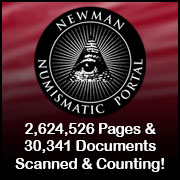
About UsThe Numismatic Bibliomania Society is a non-profit association devoted to the study and enjoyment of numismatic literature. For more information please see our web site at coinbooks.org SubscriptionsThose wishing to become new E-Sylum subscribers (or wishing to Unsubscribe) can go to the following web page link MembershipThere is a membership application available on the web site Membership Application To join, print the application and return it with your check to the address printed on the application. Print/Digital membership is $40 to addresses in the U.S., and $60 elsewhere. A digital-only membership is available for $25. For those without web access, write to: Charles Heck, Treasurer
AsylumFor Asylum mailing address changes and other membership questions, contact Chuck at this email address: treasurer@coinbooks.org SubmissionsTo submit items for publication in The E-Sylum, write to the Editor at this address: whomren@gmail.com BUY THE BOOK BEFORE THE COIN |
- WAYNE'S WORDS: THE E-SYLUM AUGUST 18, 2019
- PRESIDENT'S REPORT: NBS AT THE 2019 ANA
- 2018 BOOK PRIZE PRESENTED TO CATHARINE LORBER
- NEW BOOK: LITHUANIAN COUNTERSTAMPS 1421-1481
- NEW BOOK: THE NOTGELD OF GALICIA
- ORDERS & MEDALS SOCIETY CD AVAILABLE
- PETER GASPAR (1935-2019)
- 2019 ANA VIDEO REPORTS ON NEWMAN PORTAL
- VIDEO: 2019 SUMMER FUN: COOL COINS
- NOTES FROM E-SYLUM READERS: AUGUST 18, 2019
- VOCABULARY TERM: DISPLACEMENT
- HENRY AUGUST STERNBERG (1875-1955)
- CLASSICAL NUMISMATIC GROUP SALE 112
- BOWERS AUGUSTUS B. SAGE MEDALETS COLLECTION
- TOM BABINSZKI'S 2019 ANA DIARY
- WAYNE'S 2019 ANA DIARY: PART I
- THE INVASION OF CHAMPAIGN
- THE VAMPIRE NOTE NOTE FOUND IN A HEDGE
- BOOKSTAGRAMMERS AND BOOKTUBERS
Click here to access the complete archive a
Click here to unsubscribe (scroll down)
To comment or submit articles, reply to whomren@gmail.com
Content presented in The E-Sylum is not necessarily researched or independently fact-checked, and views expressed do not necessarily represent those of the Numismatic Bibliomania Society.
WAYNE'S WORDS: THE E-SYLUM AUGUST 18, 2019
 As noted last week, this issue is being published late due to your editor's travel to the ANA convention. Thank you for your patience.
As noted last week, this issue is being published late due to your editor's travel to the ANA convention. Thank you for your patience.
New subscribers this week include: Eleni Lianta, Catharine Lorber, Gilman Parsons, and Greg Shaban. Welcome aboard! We now have 5,961 subscribers.
Thank you for reading The E-Sylum. If you enjoy it, please send me the email addresses of friends you think may enjoy it as well and I'll send them a subscription (but let me know if they are located in the European Union). Contact me at whomren@gmail.com anytime regarding your subscription, or questions, comments or suggestions about our content.
This week we open with a report on NBS activities at the ANA convention, the 2018 IAPN Book Prize, two new books, a CD offer, and word of the loss of E-Sylum subscriber #1.
Other topics this week include Lithuanian counterstamps, Orders & Medals, updates from the Newman Numismatic Portal, collector Henry Sternberg, the CNG Sale 112, Augustus Sage medalets, and ANA convention diaries.
To learn more about NBS coffee mugs, notgeld of Galicia, Peter Gaspar, the Karystos Stater, the Old Sugar House, and the Vampire note found in a hedge, read on. Have a great week, everyone!
Wayne Homren
Editor, The E-Sylum
PRESIDENT'S REPORT: NBS AT THE 2019 ANA
NBS President Tom Harrison filed this report following this past week's American Numismatic Association World's Fair of Money. -Editor
The Numismatic Bibliomania Society’s 40th anniversary milestone is now history. It was a great week of biblio fun, education and fellowship. Again this year we hosted the NBS club table near literature dealers Charles Davis and Kolbe & Fanning. The table provided an opportunity for friends of the NBS to view items from Friday’s benefit auction, receive a commemorative 40th anniversary coffee mug for a $25 donation to the NBS, and most of all, it served as a gathering place to share our passion for the hobby.

Tom and Pam Harrison
On Thursday our Symposium featured two outstanding presentations. First we were excited to have NBS Vice President, Len Augsburger, provide a fascinating in-depth discussion on the legendary first six volumes of The Numismatist. Also, we were privileged to welcome American Numismatic Society Deputy Director, Dr. Gilles Bransbourg, who gave a presentation on the ANS publication policy and shared other news from the ANS.
Friday’s General Meeting included The Asylum author awards and the presentation of the George Fredrick Kolbe Lifetime Achievement Award. The Jack Collins Award for the best article by a first time author was presented to Michael Shutterly for his fine article Buy the Book for the Coin : Books for the Byzantine Coin Collector. The Joel J. Orosz Award for the best article appearing in The Asylum was presented to Joel J. Orosz for his outstanding article Associations : Del Bland’s William H. Sheldon - Inscribed Copy of Early American Cents : Before the Sheriff nabbed the Switcher.
The George Fredrick Kolbe Lifetime Achievement Award was last bestowed in 2015. This year the Board awarded this medal to the late Charles Ricard who with his son, Marc, designed and funded the dies for this prestigious medallic award. The meeting also featured presentations by The E-Sylum Editor, Wayne Homren, and Newman Numismatic Portal Coordinator, Len Augsburger, reporting on The E-Sylum and Newman Numismatic Portal respectively.
Again this year, our one major fundraising event, the benefit auction, was a success due to many generous donors and enthusiastic bidders stepping up to the plate. Your generosity raised over $5000 for the NBS! On behalf of the entire NBS membership I want to share a heartfelt thank you to the donors, bidders and to David Fanning for cataloging the sale and serving as our auctioneer.
The special 40th anniversary week was capped off by a tour of Dan Hamelberg’s incomparable library on Sunday. Not only was this an opportunity to visit the most comprehensive private library of American numismatic literature, but it also provided a wonderful day of fun and fellowship. A very special thank you to Dan, his wife, Connie and to Len Augsburger who made the travel arrangements.
As a result of many devoted members giving of their time, talent and resources this was an amazing week of NBS enjoyment from start to finish. THANK YOU ALL!
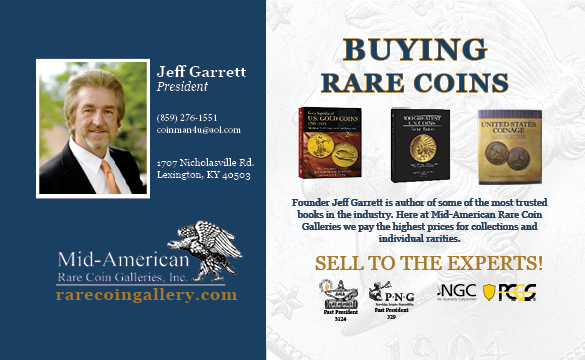
2018 BOOK PRIZE PRESENTED TO CATHARINE LORBER
Earlier this year we discussed the International Association of Professional Numismatists (IAPN) book prize for 2018, which was awarded to Catharine Lorber for her two-volume work published by the American Numismatic Society on Coins of the Ptolemaic Empire. Part I, Ptolemy I through Ptolemy IV. The award was presented this week at the IAPN cocktail party at the American Numismatic Association World's Fair of Money in Rosemont, IL. The following are remarks prepared by IAPN Book Prize organizer Peter Preston-Morley or Dix Noonan Webb. -Editor

On behalf of the IAPN Executive Committee, may we thank you, Mr President, for the opportunity to present our Book Prize for 2018 this evening.
The IAPN Book Prize is now in its 37th year, having been first awarded in 1982, when the late Dr Martin Price was the recipient. The first American winner of the Prize was Dr Robert van Arsdell in 1990. Since then Stephen Scher, David Vagi and Harrington Manville have been among those from the United States whose publications have been honoured in this way. But this year we have something of a first, in that our winner, Cathy Lorber, is the only person to have been awarded the Prize twice.
Her first award, jointly with Arthur Houghton in 2003, was for the first volume in their seminal work on Seleucid coins. This year Cathy wins the award in her own right for her 2-volume magnum opus, Coins of the Ptolemaic Empire, covering the issues of the first four Ptolemaic kings.
Cathy needs no introduction to many of you in this room. She spent almost 40 years as a cataloguer in commercial numismatics, before retiring from the commercial world 10 years ago. A graduate in Classical Greek from UCLA, she has combined cataloguing coins with publishing coin hoards and compiling specialist studies from different parts of the Greek Empire. Since 1990 she has published, or co-compiled, almost 100 studies in this field, a phenomenal achievement. Her latest work is the first significant treatment of the entire Ptolemaic series since that of the great Greek scholar, Joannes Svoronos, 110 years ago. That work was a ground-breaker in its day and those of us cataloguing these coins have used it ever since, but now we have this magnificent new study that has been recognised by the IAPN as being fully deserving of our Book Prize.
And let me say that the opposition Cathy’s title faced was among the strongest I can remember: 19 other works were submitted for consideration, all worthy of a place on any serious numismatist’s bookshelf. 2018 was indeed a memorable year for new numismatic books.
To present the Diploma and Medal to Cathy, I would like to welcome Emma Pratte, Membership Secretary of her publishers, the American Numismatic Society, and Dan Sedwick, President of the IAPN.
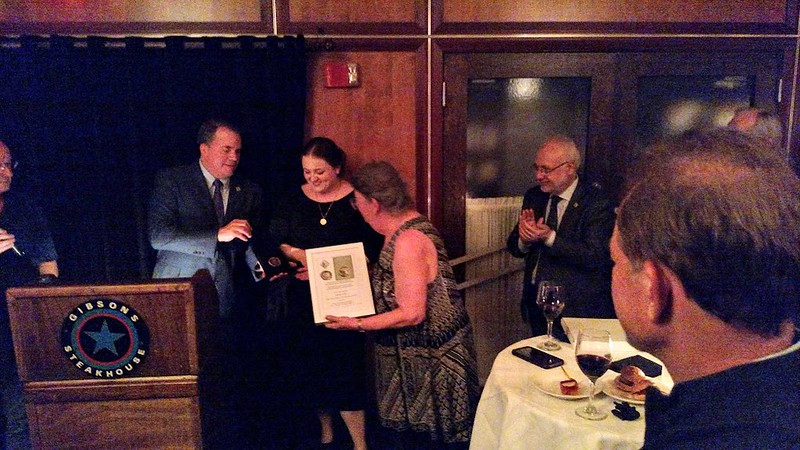
I was fortunate to obtain an invitation to the event. Above are IAPN President Daniel Sedwick, Emma Pratt of the American Numismatic Society, and Catharine Lorber receiving her award plaque. For more about the event, see my Numismatic Diary article later in this issue. -Editor
For more information on IAPN, see:
https://www.iapn-coins.org/
To read the earlier E-Sylum articles, see:
NEW BOOK: COINS OF THE PTOLEMAIC EMPIRE (https://www.coinbooks.org/v21/esylum_v21n26a03.html)
2019 IAPN BOOK PRIZES AWARDED (https://www.coinbooks.org/v22/esylum_v22n21a14.html)
THE BOOK BAZARRE
NEW BOOK: LITHUANIAN COUNTERSTAMPS 1421-1481
Dzmitry Huletski has published a new book on 15th century Lithuanian counterstamps. Here's the book's Introduction and a link to where it can be purchased on eBay. -Editor
 The practice of counterstamping one side of a coin with a small die was used infrequently in the West but was quite widespread in the East. This fact
is often explained by more oppressive traditions of power, since counterstamped currency is usually associated with increased seigniorage, or issuing
ruler profit.
The practice of counterstamping one side of a coin with a small die was used infrequently in the West but was quite widespread in the East. This fact
is often explained by more oppressive traditions of power, since counterstamped currency is usually associated with increased seigniorage, or issuing
ruler profit.
Indeed, the cost of counterstamping an old, void-of-guarantee coinage is significantly below the cost of producing a new currency. However, the countermarks do not contribute to the political prestige of the issuer, as their owned issued money would have done, and, perhaps more importantly, such money cannot become be used in international trade, since their exchange rate is guaranteed only within the state issuing them. Lithuanian countermarks circulated exclusively in areas of the Lithuanian-Horde frontier, almost without any penetration into the interior of the state.
According to A.L. Ponomarev’s classification [Ponomarev 2011. P. 48-51] counterstamped coinages are divided according to their purpose into three groups:
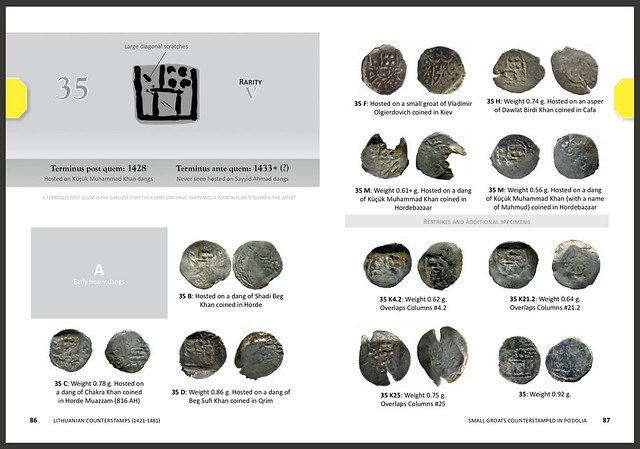
1. Returning an old, depreciated coin to circulation. Such a need could arise, for example, upon the death of an old coin issuer – former guarantor of the monetary stability – either in absence of his clear successor and/or while gaining foreign influence on the market;
2. Designating an official exchange rate to an imported coin for circulation in the markets of the state;
3. Issuing Credit, or “war” money. The state puts counterstamped currency into circulation for a short time, pledging to buy them back in quiet times at an established rate.
Counterstamping of Ulus of Jochi dangs with a stamp of Columns, initially a personal sign of the Grand Duke Vitovt the Great, began in the early 1420s and continued intermittently for a little less than half a century. These coins then echoed even later in the East border town of Mstislavl. The first “reference timepoint”, for the beginning of Lithuanian counterstamped coinage is September 1421, when Beg Sufi Khan died. He was the “Emperor of Solkhat”, and Vitovt’s protege on the “Small sultanate”’s throne of Qrim (Crimea).
At the current level of our knowledge, it cannot be completely excluded that the counterstamping could have begun a little earlier. However, there are no compel- ling reasons to insist on this possibility at the moment. Thus, the first of the options described above (returning an old, depreciated coin to circulation) was the likely cause of action by Vitovt’s financiers. It was a need to maintain the currency of the state partially dependent from Lithuania during the civil war begun immediately after the death of Vitovt’s protege. It is important to note, that this currency – the Jochid dang – was also the main means of monetary circulation in the border areas of the Grand Duchy itself.
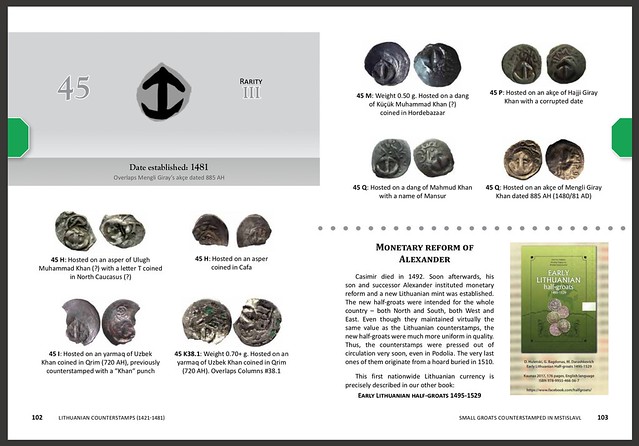
Later, the second cause of counterstamping (delivering an official exchange rate to an imported coin) also contributed to the longevity of the undertaking. An approx- imate equality of silver content of a Prague groat minted by the Czech king Vaclav IV, the main currency in contemporary Lithuania, and two Western-Jochid dangs of the 1420s provided extra convenience for trade. Still, even this convenience didn’t enable the small groats – Lithuanian counterstamps – to penetrate much inside the interior lands of the Grand Duchy. In Rus’, called грошики or полугрошки, this name of counterstamped dangs appears in various written sources originating from the Podolia region. They didn’t spread throughout Lithuania, like Prague groats, remaining artifacts of local, Lithuanian-Jochid borderland monetary circulation.
The counterstamping was held perhaps in four regions of the Lithuanian-Horde frontier. During the first stage, dangs were counterstamped predominantly in Severia (somewhere close to Kursk, Trubchevsk, Novgorod-Severski), starting in the early 1420s for almost a decade. Possibly, these overstrikes were imposed in significantly reduced quantities, even into the 1430s. The second stage of counterstamping took place at mints that were situated further in the west, perhaps as far as the city of Kiev. Their production also dried up by 1430 or soon afterwards. The third stage of counter-stamping started in Podolia (close to Braclav and maybe Kamenec-Podolski) probably in the late 1420s, and lasted for the longest period of time, until about 1460. The latest known counterstamping of Jochid silvers was held in Mstislavl far in the northeast.
Hardcover
Pages: 104 pages
Price: $45
For more information, or to order, see:
https://www.ebay.com/itm/153609488535

NEW BOOK: THE NOTGELD OF GALICIA
Here's a new book on the WWI-era notgeld (Emergency Currency) of the Galicia region of eastern Europe. Found via the August 13, 2019 issue of News & Notes. Here's a Google-translated description. -Editor
 Oleg Klimenko and Wilfried Trillenberg
Oleg Klimenko and Wilfried Trillenberg
Research institute of the international scientific association world economy and world politics e.V. Berlin:
"The Emergency Money of Galicia - Local and Private Notgeld in Eastern European Galicia 1914/1923"
119 pages, with many colored illustrations, size 19 x 25 cm, perfect binding booklet,
Berlin 2019, price 23,50 Euro
ISBN no. 978-3-9818256-6-4
In the Internet age, textbooks on various topics are also very popular in the field of numismatics, especially in special areas that can not be published by traditional publishers for business reasons. The Ukrainian numismatist Oleg Klimenko and dr. Wilfried Trillenberg, director of the aforementioned research institute, published this book on emergency money in Galicia about 100 years ago as No. 47/19 in the series "European Integration, Basic Questions of Theory and Politics" of the institute.
It offers a great deal in the nine chapters, but it is - to anticipate it - not a "classic catalog" for collectors. The first few chapters describe very clearly the chaos in economics and trade that arose not only in Galicia, but in many countries after the end of the gold standard of 1914 and the First World War. The reading will also be of interest to those who are not much concerned with numismatics, as many aspects, including the fate of prisoners of war from the battles of the First World War, are dealt with. About the history of Galicia and Western Ukraine can be found today in the standard history books only relatively brief information, which also applies to Polish catalogs to Galicia's paper money. Here, collectors of Polish paper money will find plenty of background information, for which there is usually no place in catalog works and which are mentioned in the preface at best.
As far as the "Catalog Part" is concerned, we find here alphabetically arranged lists of places in Polish, which may also include Ukrainian names. The issued bills are given with nominal value and additional information, such as paper, stamp and special features such as signatures and - if known - date. A classic numbering does not occur. In the estimation of the author of these lines, this catalog is the most comprehensive, so far in Galicia, in terms of the number of positions. So "collectors" can very well find out which places have spent money at that time, for private as well as communal, d. H. "Official" paper money applies. Pictures of different banknotes we find significantly smaller at the end of the book in good quality. Anyone who has been dealing with the emergency money of Galicia for some time will perhaps own the OG 50 on page 91 or have seen it in the original. This is the 100-crown Assignatenschein 1915 the city of Lviv.
Of course, after 100 years and two wars, as well as many turmoil of the time, very few of the once-spent paper banknotes have been left, most of which may already be in collections - or even awaiting discovery? Of course, this book does not quote prices for the documented bills because all of these are rarities and many no longer exist.
For small-town signs, those who are personally interested in this symbol often pay "fantasy prices". Most Ukrainian and Polish paper money collectors in Galicia focus on the government bills that were running around, and they are quickly finding out, for example, here. at Poland in the interwar period 1919-1939 on borders. Anyone who can put one or the other private bill of a Galician place in the collection, may be pleased, because many will not be able to gather even with abundant money.
All in all, this book is a really worth reading for historically interested paper money friends who want to learn more about the area of ??Galicia 100 years ago. This circle can only be recommended for this book, which at the end contains summaries in German and Ukrainian. The inclusion of such in Polish would probably have greatly expanded the circle of interested parties.
For more information, or to order, see:
Klimenko/Trillenberg: "Das Notgeld Galiziens
(https://www.geldscheine-online.com/post/klimenko-trillenberg-das-notgeld-galiziens)

ORDERS & MEDALS SOCIETY CD AVAILABLE
In April Frank Draskovic of the Southern California Orders & Medals Society made a nice offer to E-Sylum readers. Some folks have taken them up on it, and Frank asked me to remind everyone the offer still stands. -Editor
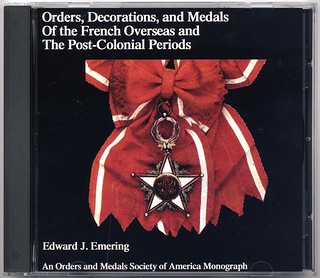
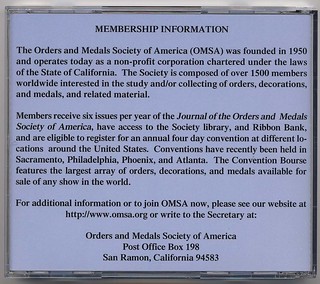
At the Orders & Medals Society of America (OMSA) website (www.omsa.org), you will find under the publications tab, this CD book* (description below). It seems they made too many of these a few years back, so they were giving them away at last year's convention.
Orders, Decorations, and Medals of the French Overseas and the Post-Colonial Periods
By: Edward J. Emering.
From Algeria and Annam to Togo and Tunisia the author has opened the door to the fascinating world of French colonial medals. Over three hundred and eighty color illustrations document and catalog the awards. Our first on CD!
I suggested, and OMSA agreed to, a joint effort with the Southern California Orders & Medals Society to offer these CDs gratis to readers of numismatic publications to inform and entice collectors to consider this endlessly fascinating medallic specialty, which is far too little known in American numismatic circles.
We are offering the CD free for only the media mail (the ONLY shipping method I will use) postage & mailer cost of $3.00 each in cash only, that amount to be remitted to me by USPS mail only (no checks, no credit cards). The Southern California Orders & Medals Society.
I ask that anyone interested kindly email me first with their request (only one CD book per name and address & shipment to USA addresses only). I'll then confirm availability by email and ship after the $3.00 cash payment is received. So that's it.
Frank Draskovic
Southern California Orders & Medals Society
PO Box 803
Monterey Park, CA 91754-0803
Email: fdraskovic@hotmail.com
Thanks again to Frank, OMSA and SCOMS for their generosity. As I noted before, it's a professionally done affair and I encourage anyone with an interest or just numismatic curiosity in general to request a copy and check it out. -Editor
To read the earlier E-Sylum article, see:
ORDERS &MEDALS SOCIETY CD OFFER (https://www.coinbooks.org/v22/esylum_v22n17a09.html)
For more information on the Orders & Medals Society of America, see:
https://www.omsa.org/

PETER GASPAR (1935-2019)
Peter Gaspar, E-Sylum subscriber #1, has passed. Professor Emeritus of Chemistry at Washington University in St. Louis, Gaspar signed on in September, 1998. He submitted many articles and comments over the years on topics as varied as purity and brittleness of gold, nondestructive analysis of 1792 silver center cents, the Newman Money Museum, Numismatics in Fiction, "dateless" 20 pence coins, "Numismatics in the Age of Grolier," and extracting coin embedded in Lucite.
I was fortunate to finally meet him one day in St. Louis, as we both attended an early meeting called by Eric and Andy Newman to plan what would eventually become the Newman Numismatic Portal. So Peter was present at the inception of both of my major online numismatic projects.
He was proud to be our first subscriber, and I'm equally proud to have known him. Rest in Peace, old friend. -Editor
Len Augsburger writes:
“With the Newman Numismatic Portal administered through Washington University in St. Louis, it was an easy decision to invite faculty member Peter Gaspar to the formative meetings. Gaspar spoke with authority and always captured the attention of the room. Gaspar’s numismatic interest focused on early English coinage as well as the technical aspects of mechanics and metallurgy, for which Eric P. Newman frequently sought his counsel. Gaspar served on the board of the American Numismatic Society and made important contributions to the numismatic literature that will continue to bear fruit. Gaspar was first a research chemist, and might have wished to dedicate more time to numismatic endeavors, but still contributed significantly to the field. He will be missed.”
This obituary was published August 12, 2019 by Washington University in St. Louis. -Editor
 Peter P. Gaspar, professor emeritus of chemistry in Arts &Sciences at Washington University in St. Louis, died Saturday, July 27, 2019, in St.
Louis, following a long illness. He was 84.
Peter P. Gaspar, professor emeritus of chemistry in Arts &Sciences at Washington University in St. Louis, died Saturday, July 27, 2019, in St.
Louis, following a long illness. He was 84.
Gaspar was born in Brussels in 1935 and moved with his family to the United States in 1939. He earned his undergraduate degree at the California Institute of Technology and his PhD at Yale University in 1961. Gaspar began teaching at Washington University in 1963 and taught and conducted research at the university until his death in 2019. He was a physical-organic chemist and a leader in the field of organosilicon chemistry.
“He specialized in the pursuit of fleeting, reactive intermediates known as silylenes,” said William Buhro, the George E. Pake Professor in Arts &Sciences and chair of chemistry. “A highlight of his career was his recognition by the American Chemical Society with the Frederic Stanley Kipping Award for organosilicon chemistry in 1986. Peter was also a large figure in the life of the chemistry department. He will be missed.”
He was a fellow of the Royal Society of Chemistry, the American Numismatic Society and the Royal Numismatic Society (Great Britain). His honors include the American Numismatic Association’s Heath Literary Award in 1980. He held many appointments as a traveling lecturer, including with NATO, the French Ministry of Education and as a Fulbright scholar.
Gaspar is survived by his wife, Ann Carole Gaspar, and son, Damon Gaspar, both graduates of Washington University and residents of St. Louis. His family is organizing a memorial service, which will take place in the fall.
Douglas Saville of Reading, England writes:
I knew Peter Gaspar, and came to respect him over the 50 years I knew him, for many reasons. The fact that Peter Gaspar – actually, he was Professor Emeritus of Chemistry - was subscriber number 1 to The E-Sylum in September 1998, indicates his commitment to our subject. He was a man of great intellect, and he applied that to all areas which interested him, and, fortunately for us, coins were included, from an early age.
I have fond memories of Peter coming to London between 1969 and 2000, when I was working at Spinks, and editing their publications from the 1980s, and we always found the time to meet up. Mostly he would be travelling to London for Conferences in the UK, or simply stopping off there for a day or two, and on his way elsewhere in Europe. And it was good for me to meet up with Peter. We usually had a pub lunch – sausages, beans and chips, and a pint or two of beer were his favourites.
I would often have problems connected with books I was editing, or articles submitted for the Numismatic Circular, that I found difficult to sort out - and he usually had the answer, or at least suggestions that I could reasonably put to the authors…… a great help for me. He always had a certain view on a subject- any subject in fact, but he delighted in anything connected with coins. His main interests were in the British hammered series, but also the techniques of minting coins, especially later minting machinery, fascinated him - and he was a great authority on the processes connected with the manufacture of coins. For many years, and until recently, he was Corresponding Member for the United States of the British Numismatic Society - and he served the Society and the subject admirably.
Peter sent me his latest list of “Numismatic Literature Wants” in December 2014 - he had been sending me such “Wants” for many years – the first was probably mailed to me in the mid-1970s when I was at Spinks……. the obscurity of some of the items listed on those lists is indicated by the fact that the lists never significantly reduced in extent over the years……. Some books, I know, remained there for 40 or more years……….! He was ecstatic if I ever found anything on those lists………
And that reminds me. A close numismatic friend of Peter’s was Harry Manville. Harry passed away in February 2015. I dispersed Harry’s monumental library. It was a huge task - some 110 large boxes were packed and shipped to the UK. In the course of taking the books off the shelves and packing them – it was shelved in 5 or 6 rooms in Harry’s large house in Washington DC - I noticed a note on one of the volumes, a very rare mid-19th century work by Henry Christmas on British Coinage. The volume had been sold by me to Harry in the early 1970s, and at the time Harry, enthusiastic about the purchase, told Peter that he had bought it from me. Peter was dismayed as he had been searching for a copy of that book for years. Harry left instructions that it was to be bequeathed to Peter upon Harry’s death and the disposal of his library. I sent the book to Peter, and he was delighted - he got his book – just some 40 years later!
Gaspar's writings for the NBS journal The Asylum include "English Coins, from the seventh century to the present day by George Cyril Brooke (1932)" and "Numismatics in Fiction - A Trial List"
He will be missed. -Editor
For more information, see:
Obituary: Peter P. Gaspar, professor emeritus of
chemistry, 84 (https://source.wustl.edu/2019/08/obituary-peter-p-gaspar-professor-emeritus-of-chemistry-84/)
Peter Gaspar ?Professor Emeritus of Chemistry
(https://chemistry.wustl.edu/people/peter-gaspar)

2019 ANA VIDEO REPORTS ON NEWMAN PORTAL
The latest additions to the Newman Numismatic Portal are video reports from the 2019 ANA World's Fair of Money. Project Coordinator Len Augsburger provided the following report. -Editor
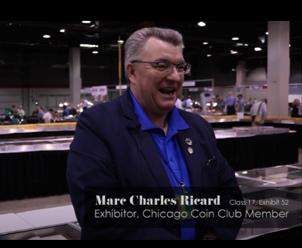 This week Newman Portal sponsored the creation of a series of daily video reports from the ANA convention, produced by Lianna Spurrier. Starting with
the ribbon cutting on day 1 (Tuesday), Spurrier covers all aspects of the show from exhibits to auctions to bourse personalities and, of course, coins.
This week Newman Portal sponsored the creation of a series of daily video reports from the ANA convention, produced by Lianna Spurrier. Starting with
the ribbon cutting on day 1 (Tuesday), Spurrier covers all aspects of the show from exhibits to auctions to bourse personalities and, of course, coins.
Dealer Shanna Schmidt, recently elected to the ANA board, appears on the day 2 video (Wednesday), while day 3 (Thursday) brings coverage of the sale of the 1894-S dime at the Stack’s Bowers auction. In the day 4 video, Benjamin Franklin (aka Pat McBride) makes a surprise appearance and notes that the colonial paper money he printed 300 years ago has held up surprisingly well. This was the first large show Spurrier has attended and she brings a new and refreshing perspective to the convention experience.
Image: Marc Ricard speaks on his collection of books on Napoleonic medals (day 4).
These are well worth watching. Lianna does a great job. -Editor
Link to Lianna Spurrier ANA convention videos on Newman Portal:
https://nnp.wustl.edu/library/multimediadetail/529486?Year=2019&take=50

VIDEO: 2019 SUMMER FUN: COOL COINS
These are selections from the David Lisot Video Library that feature news and personalities from the world of coin collecting. David has been attending coin
conventions since 1972 and began videotaping in 1985. The Newman Numismatic Portal now lists all David’s videos on their website at:
https://nnp.wustl.edu/library/multimediadetail/522852
Here's one on Cool Coins, Currency & Collectibles at the 2019 Summer FUN Coin Convention. -Editor
Cool Coins, Currency & Collectibles Summer FUN Coin Convention July 2019. VIDEO: 11:08.
 David Lisot, Interviewer, CoinTelevision.com with John McIntosh, George Watson, & John Yasuk.
David Lisot, Interviewer, CoinTelevision.com with John McIntosh, George Watson, & John Yasuk.
Orlando Summer Florida United Numismatists Convention had some great collectible items. Host David Lisot finds out about Disney Dollars that include a 2005 Disney Mickey Mouse $50, 2005 Donald Duck $5, 1999 Minnie Mouse $10, and he talks to a dealer with bulk Roman coins that include a bronze Constantine I and Constantius I. Finally he talks to someone about the 1897 Philippines Silver Peso, 1936 Roosevelt Murphy Peso, Murphy Quezon Silver Peso, and the 50 centavo of that set.
An excerpt of the video is available for viewing on the Coin Television YouTube Channel at:
https://youtu.be/Hw3ZC5r-fwU
This video is a highlight from FUN Summer Coin Convention Highlights 2019

NOTES FROM E-SYLUM READERS: AUGUST 18, 2019
Corrections: Remembering Simon Bendall
We had a typo in Anthony Portner's surname in last week's issue. Sorry! We'll fix that in our archive. Here are some additional errata to Peter Clayton's eulogy of Simon Bendall. -Editor
1) The fall of Constantinople was the 29th May 1453 not 23rd October 1453.
2) An Introduction to The Coinage of The Empire of Trebizond was published in 2015 not 1979 and Simon Bendall was the sole author.
3) Volume V of the Catalogue of the Byzantine Coins in the Dumbarton Oaks Collection and in the Whittemore Collection was originally published in 1999.
4) Robin Porteous was present at the commemoration service
Thanks again to Peter Clayton and Anthony Portner for sharing their remembrances and these updates. -Editor
To read the earlier E-Sylum article, see:
REMEMBERING SIMON BENDALL (https://www.coinbooks.org/v22/esylum_v22n32a14.html)
THE BOOK BAZARRE
VOCABULARY TERM: DISPLACEMENT
Dick Johnson submitted this entry from his Encyclopedia of Coin and Medal Terminology. Thanks. -Editor
Displacement. The result of metal movement within a struck blank caused by the configuration of the die and the metal mass seeking to fill the nearest cavities of the die. The movement of the mass is called metal flow, displacement is the result of this plastic flow of solid material. There is some displacement throughout the blank (if it is one homogeneous mass, not clad) but it is obvious to observe as surface displacement, which forms the design, the modulated relief of the contours and cavities of the die.
Metal tends to flow towards the greatest die cavity during striking. The force of the blow causes nearby metal to flow into that cavity; it draws adjacent metal mass to replace the metal which flowed into the cavity. This movement of solid material, metal flow, redistributes the metal throughout the mass of the blank until all die cavities are filled (although this happens instantly).
The blank's mass is reshaped until it fits exactly the intended configuration of both dies (also expanding slightly to the limits of the collar). The design is formed, not by surface displacement alone, but metal flow occurs throughout the metal blank.
Obviously, displacement is best observed on the surface. However, we can view the displacement within the struck piece if a coined piece is dissected and the change of internal grain structure is and the metal flow effect can be observed. Or, it can also observed by a lamination error where a layer of struck surface metal is severed from a coin. A minute amount of displacement can be observed within the exposed mass.
Interestingly, displacement does not occur beyond the first layer of clad metal. Numismatic writer Walter Breen named the line between two clad layers as the boundary. This is apt because displacement does not extend beyond the boundary of the first layer in clad coins.
Looking for the meaning of a numismatic word, or the description of a term? Try the Newman Numismatic Portal's Numismatic Dictionary at: https://nnp.wustl.edu/library/dictionary
Or if you would like a printed copy of the complete Encyclopedia, it is available. There are 1,854 terms, on 678 pages, in The Encyclopedia of Coin and Medal Technology. Even running two a week would require more than 19 years to publish them all. If you would like an advance draft of this vital reference work it may be obtained from the author for your check of $50 sent postpaid. Dick Johnson, 139 Thompson Drive, Torrington, CT 06790.

HENRY AUGUST STERNBERG (1875-1955)
 Henry August Sternberg (1875-1955), was born on September 27, 1875, in Illinois of German immigrant parents from Mecklenburg, Charles and Fredericka
Schroeder Sternberg.
Henry August Sternberg (1875-1955), was born on September 27, 1875, in Illinois of German immigrant parents from Mecklenburg, Charles and Fredericka
Schroeder Sternberg.
He was a resident of Dundee, Kane County, Illinois. Sternberg had a general store carrying a wide variety of merchandise from clothing, shoes, boots, hats, to hardware items like window shades, and linoleum. He retired in 1923 from his firm : H. A. Sternberg & Co., 123 West Main Street, Dundee, Illinois.
Henry, his wife and two children were all involved in coin collecting and in ANA as well as local coin club events. Henry is known for having one of the best early U.S. gold coin collections as well as early American copper cents with famous red uncirculated 1793 specimens.
In May 26, 1897, he married Lora Bumstead, daughter of James H. Bumstead and Annie Masters Bumstead. They had a son Earle (1898-1991).
On August 11, 1902, he married Alice Wilcox Hill (1876-1964), at Dundee, Kane, Illinois. They had a daughter Ellen Belle (1913-1988).
In the 1910 U. S. Census he is listed as a retail dry goods merchant living at 25 Oregon Avenue, Dundee, Kane, Illinois. Sternberg began collecting prize change over the counter and studied coins received in his store. Over time he would assemble several fine collections that have attained fame with many specimens today some of the rarest and finest known.
When a passenger elevator was installed in his store in February 1914 notice ran in The McHenry Plaindealer, Thursday, February 26, 1914, page 1.
 He began buying coins from Henry Chapman in March, 1917.
He began buying coins from Henry Chapman in March, 1917.
He applied for membership in the ANA in January 1918. He became ANA Member No. 1960.
The 1920 U. S. Census lists him as the owner of a department store and his son Erle working for him living at 232 Third Street, Dundee, Kane, Illinois.
In 1920 he and his wife attended the ANA Convention in Chicago.
His wife also joined the Chicago Coin Club with him.
In January 1925 he and his wife and daughter Ellen Belle announced the forming of the Dundee Numismatic Club, with three charter members. Erle joined later.
Henry Sternberg was a member of the Board of Education not long after his retirement and stayed on for 13 years.
The 1930 U.S. Census lists him as retired living at 143 4th Street, West Dundee, Kane, Illinois.
In 1930 he bought some of the French collection.
The 1940 U.S. Census lists him as retired living at 212 North 4th Street, Dundee, Kane, Illinois.
He consigned coins to the J. C. Morganthau Sale #305 held April 7-8, 1933. The sale included coins from the Beckwith and French collections. And Sternberg had some of the rarest and best known early Cents. His reputation preceded him : "Sternberg bought 9 1793's, the 1797's and 1798's, 1 1799, 10 1800's, 7 1801's, as well as some of the dates of 1821 to 1829."
Morganthau's Preface to the sale read :
THE STERNBERG COLLECTION
We offer in this catalogue some of the finest and rarest coins it was ever any cataloguer’s privilege to describe. They form the residue of the wonderful collection formerly owned by Mr. H. A. Sternberg of Dundee, 111., who has been gradually disposing of his coins for several years. Singularly, many of his finest and rarest coins remain until last and are offered in this catalogue. We disposed of part of his collection of Cents in our sale of April 26, 1932, which accounts for the missing dates in this present offering.
An opportunity is here offered Cent Collectors to secure some of the finest and most famous Cents in existence, Cents . which have been in the great Collections of the past. This pedigree of past ownership, if it doesn’t mean anything else, certainly does mean that the coins were the finest obtainable to a long line of earnest collectors who were willing to spend lavishly of their time and money to secure the best.
 On August 11, 1952, Henry and Alice celebrated their 50th Wedding Anniversary.
On August 11, 1952, Henry and Alice celebrated their 50th Wedding Anniversary.
He died at his home on November 4, 1955.
His numismatic library and the remainder of his coins were sold posthumously at auction by Bolender on March 2, 1956 including as is often cited 133 large cents, 40 of which were 1794's.
The catalogue for his library :
NUMISMATIC BOOKS & LITERATURE
Collectors of U.S. Large Copper Cents will find here the best books on that series of American numismatics. These books are from the library of the late H. A. Sternberg, who was one of our greatest collectors of this series, for almost 50 years.
633. Crosby, S.S. The United States Coinage of 1793 Cents and Half-cents. Boston 1897. 36 pp. plus 3 pages of plates. Original, with additional article by Geo. H. Clapp on the subject. Brown cloth. Fine. Rare. $10.
634. Hays, W.W. Varieties of U.S. Cents of 1794. New York 1893. Edited by Ed Frossard. Original with plates. Red cloth. Fine &rare book. $15.
635. Chapman, S. H. The United States Cents of the Year 1794. Phila. 1926. Large ..., blue cloth, with 4 pages of plates. Very good. $10.
636. Clapp, George H. The U.S. Cents of the Years 1795, 1796, 1797, and 1800. Howard R. Newcomb assisted in this work. Splendid treatise with fine plates. Blue cloth bound. Very fine. $20.
637. Gilbert & Elder. The U.S. Cents of 1796, published in 1909. With plates. Also U.S. Cents 1804 to 1814, by Geo. H. Clapp, pub. 1941 in Coin collector series booklet, illust. Fine. Sold as one. $6.
638. Clapp, George H. The United States Cents of the Years 1798 and 1799. Published in 1931. Excellent work with plates of the best. Leather bound. V. fine. $15.
639. Newcomb, Howard R... The U.S. Cents of the Years 1801, 1802, 1803. Detroit 1925. With finest plates. Large size, brown cloth. V. fine. $12.50.
640. Doughty, F. W. The Cents of the United States, 1793 to 1814. Reprint from original pub. in 1890. Cloth. V. fine. $5.
641. Sheldon, William H. Early American Cents 1793-1814. Published in New York 1949. Excellent work, 339 pp. plus plates V. fine. $7. F
642. Howard R. Newcomb, UNITED STATES COPPER CENTS 1816-1857. 284 large pages 9x12 in. plus 11 pp. of fine plates. Also catalogue of the sale of Newcomb’s great collection of large cents, from 1816-1857. Sold as one. V. fine. $15.
643. Beckwith, Dr. Henry W. Priced auction sale catalogue, with plates, sold by S. H. Chapman 1923. The quality of the large cents in this sale was of the very finest. $15.
644. The Dr. Geo. P. French Collection. 1930 catalogue by B. M. Mehl. Descriptions of over 800 large cents in the great French coll’n. Flexible leather cover. V. fine. $10.
645. Famous Collections of Large Cents. Catalogues of several great collections including Major Richard Lambert (1910) with plates &prices; Fred B. King (1927) priced; Dr. J. M. Henderson (1921) priced; T. James Clarke (1929) priced; Dupont sale priced with plates (1949); Wm. Schleicher (1919) priced; Jascha Heifetz (1938) priced with plates; Homer K. Downing (1952) priced with plates; Allison W. Jackman (1918) partly hand-priced, and several others. Sold as one lot. $25.
646. Lot of 17 auction sales catalogues from 1917 to 1941, mostly priced, some with plates. Includes some great or famous collections, incl. the great Jenks sale of 1921 partly priced with names of some buyers. One lot. $20.
647. Adams &Woodin. UNITED STATES PATTERN, TRIAL, and EXPERIMENTAL PIECES. Original of this fine illustrated book, the authority on pattern coins. 195 pp. Blue cloth, pub. in New York in 1913. V. good, some prices penned in. $7.50.
648. Gilbert, E. U.S. Half-Cents. Accepted authority. Not bound and no plates, but all half-cents can be properly attributed. Also a priced plate catalogue of famous Hillyer Ryder coll’n. of half-cents. Sold as one. $5.
649. Andrews on U.S. Cents 1816-1857, paper cover reprint. New York Store Cards by Edgar H. Adams 1913. Coins & Tokens of Canada by Raymond 1937. Dunham's Easy Finding List. Early N.Y. Merchants’ Tokens by Raymond 1936. Annual Report of Director of Mint for year 1917. Only the last bound, others paper covers. One lot. $10.
650. Haseltine, John W. U.S. Early Silver quarters, half-dollars and dollars. 1927 reprint. Good. $7.50.
651. Browning, A. W. The EARLY QUARTER DOLLARS OF THE UNITED STATES FROM 1796 to 1838. Pub. in New York in 1925. With 8 pages of plates. The authority on quarters. Red cloth. Fine. $15.
652. U.S. Early Silver Dollars, by M. H. Bolender 1950. Large size 9x12 inches, with plates to show 156 illustrations. Blue cloth, about as new. The standard authority on the subject. Autographed by the author. $9.
653. A Table of English Silver Coins, by Martin Folkes. A very old large book printed in London in 1745. About 9x12 in. boards. Covers English coins from the Norman conquest to 1745. Interesting thing. Covers poor, contents fine. $5.
To read the complete article, see:
STERNBERG, HENRY AUGUST
(https://sites.google.com/a/numismaticmall.com/www/numismaticmall-com/sternberg-henry-august)
The entire inventory of the Lupia Numismatic Library is for sale. Individual items will be available before the remaining archives are broken up into parcels sold at philatelic auctions in the U. S. and Hong Kong. Check NumismaticMall.com frequently as dozens of new items with estimates will be posted daily until everything is sold.
All inquiries will be given prompt and courteous attention. Write to: john@numismaticmall.com .
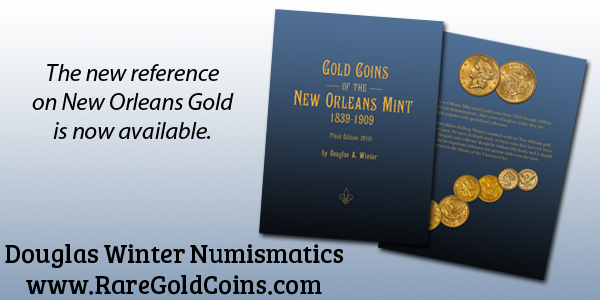
CLASSICAL NUMISMATIC GROUP SALE 112
Here's the press release for the CNG fall sale. Some great coins here. -Editor
An Internet and Mail Bid Sale
Closing Electronically on Wednesday, 11 September 2019, from 10 AM ET
Classical Numismatic Group is proud to present CNG 112, an Internet and Mail Bid Sale closing electronically on Wednesday, 11 September 2019, from 10 AM ET (U.S.). This sale offers 856 lots with a presale estimate of $1.95 million.
Our annual fall sale features Greek, Celtic, Oriental Greek, Central Asian, Roman Provincial, Roman Republican, and Roman Imperial coinage. Additionally, there are featured selections of Byzantine, Early Medieval, Islamic, World, British coinage and British medals.
CNG 112 is highlighted by a number of collections and individual rarities, which make up the majority of coins on offer:
- Selections of Greek, Roman, and British Coinage from the Matthew J. Curtis Collection
- Greek Coins from the Baldwin Maull and John L. Cowan Collections
- An Extensive Offering of Tarentine Silver
- Pedigreed Naxos Tetradrachm
- Greek Electrum from the Siren Collection
- Kroisos Prototype Gold Stater
- High Grade Double Dinar of Vima Kadphises
- An Offering of Rare Sasanian Gold Dinars
- Further Selections from the Michel Prieur Collection of Syro-Phoenician Silver Coinage
- Roman Republican Coins from the Andrew McCabe Collection
- A Diverse Selection of Roman Imperial Gold
- Superb Pedigreed Constantine I Tricennalia Solidus
- AH 132 Dinar of Marwan II – Key Last Year of the Umayyad Series
- Earliest Dated Taler – 1486 Sigismund of Austria
- Further Selections from the G.W.K. Roberts Collection of British Milled Coinage
Catalogs for CNG 112 have been mailed to our active mailing list and bidding is open on the site. Some of the individual highlights from CNG 112 are:

Lot 30 – CALABRIA, Tarentum. Circa 280-272 BC. AR Nomos (20.5mm, 6.52 g, 5h). Reduced standard. Nude youth, crowning horse upon which he sits right;
FI?OKPA to left, monogram below / Phalanthos, nude, holding trident and small Nike, who crowns him, riding dolphin left; APISTO below. Vlasto 867; HN Italy
998. Attractively toned. Near EF. Well centered and a lovely example of the type.
Estimated at $750
From the Matthew Curtis Collection. Ex Vinchon (14 December 1999), lot 715.
Published by Cahn

Lot 80 – SICILY, Naxos. Circa 460 BC. AR Tetradrachm (28mm, 17.23 g, 11h). Bearded head of Dionysos right, wearing tainia decorated with an ivy
branch / Silenos, nude and bearded, squatting facing, his head turned left, looking at a kantharos he is holding up in his right hand, and supporting himself
with his left hand on the ground to the lower right, his tail emerges from behind, and extends across the ground below; N-AXI-ON around; all within shallow
concave circle. Cahn 54.25 (this coin); HGC 2, 983; SNG ANS 515; SNG Fitzwilliam 1108; SNG Lloyd 1150 = Warren 271; SNG Lockett 840; Gulbenkian 230–1; Bement
418; Berlin 571; BMC 7–8; Boston MFA 302–3; Hunt IV 79; Jameson 673; Kraay & Hirmer 6; Locker-Lampson 79; de Luynes 1060; McClean 2466; Rhousopoulos 349;
Rizzo pl. XXVIII, 2; Weber 1466; (all from the same dies). Attractively toned, with much of the original find patina remaining, some minor scratches at the end
of Dionysos’ beard. Struck at an early die state, thus only a hint of die break that develops on the obverse is visible. EF. Well centered and struck. A
masterpiece of late Archaic art with exceptional composition.
Estimated at $500,000
Ex collection of Edmond Dresse de Lesbioles, Liege; Ars Classica XVII (3 October 1934), lot 174.
Located on the eastern shore of Sicily in the shadow of Mt. Aitna, Naxos was the oldest of the Greek colonies on the island, founded in 735 BC by colonists from Chalkis in Euboia and Ionia. According to the historian Thucydides (1.100), Naxos established its own colony by founding Leontini in 730 BC, which was soon followed by the foundation of a second colony, Aitna, later known as Katane. Owing to the fertility of the surrounding volcanic soil of Mt. Aitna, Naxos developed an economy of viticulture, and along with Leontini and Katane, became very prosperous. This wealth attracted the attention of Syracuse, which subjugated Naxos in 476 BC, removing its citizens along with those of Katane to Leontini.
Following the death of Hieron in 461 BC, the Naxians were able to return to their homes and refound their city. In commemoration, this issue of tetradrachms was struck (Carmen Arnold-Biuuchi, The Randazzo Hoard [1990], p. 29). Featuring Dionysos on the obverse and the satyr Silenos, the half-man, half goat follower of Dionysos, on the reverse, they are one of the most famous coin types minted in antiquity. A superb example of early classical art, while still retaining some of the typical elements of archaic art, these tetradrachms were struck from a single pair of dies. The artist, clearly a master die-engraver and arguably the finest of his time anywhere in the Greek world, is known today as the “Aitna Master”, after a unique tetradrachm of Aitna in the Bibliothèque royale de Belgique (for a discussion of the “Aitna Master” and his association with this tetradrachm of Naxos, see François de Callataÿ, "On the Style of the 'Aitna Master' from Eastern Sicily," Israel Museum Studies in Archaeology, Volume 3 [2004], pp. 43-52). While the head of Dionysos is exceptional in its modeling, the kneeling Silenos is even more striking for its mastery of anatomical techniques, including the foreshortening of the right leg. Here, the clearly inebriated Silenos is managing to balance himself, but the manner in which he peers at his cup adds a trace of naturalistic humor to the composition.

Lot 170 – EUBOIA, Karystos. Circa 300-250 BC. AR Stater (22.5mm, 7.48 g, 1h). Cow standing right, head left toward calf suckling left / Cock standing
right. Robinson, Carystus 24 (A3/P11); BCD Euboia 569; HGC 4, 1552. Old collection tone. VF. Well centered, good metal for issue.
Estimated at $1,000
From the Baldwin Maull Collection, purchased from Coin Galleries, 1960.
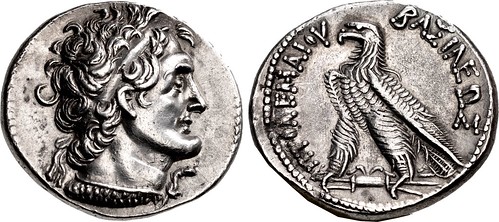
Lot 378 – PTOLEMAIC KINGS of EGYPT. Ptolemy VI Philometor. First sole reign, 180-170 BC. AR Tetradrachm (27.5mm, 14.11 g, 12h). Alexandreia mint.
Diademed head of Ptolemy I right, aegis around neck / Eagle standing left on thunderbolt; no control marks. Svoronos 1489; Olivier 4225–9 (obv. die D163); SNG
Copenhagen 262–8. Lightly toned, trace deposits, a couple light marks under tone. Near EF. High relief.
Estimated at $500
From the John L. Cowan Collection. Ex Gemini XIII (6 April 2017), lot 108.
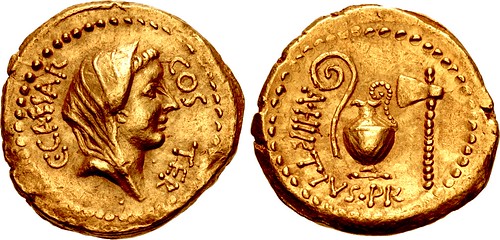
Lot 551 – The Caesarians. Julius Caesar. Early 46 BC. AV Aureus (19.5mm, 8.22 g, 6h). Rome mint; A. Hirtius, praetor. Veiled female head (Vesta or
Pietas?) right; C • CAESAR COS TER around / Emblems of the augurate and pontificate: lituus, guttus, and securis; A • HIRTIVS • PR around
from lower left. Crawford 466/1; Molinari 83 (D3/R212); CRI 56; Calicó 36; Sydenham 1018; BMCRR Rome 4052; RBW 1635. Good VF, A few light marks and scratches.
Struck from an obverse die of fine style.
Estimated at $5,000

Lot 603 – Nero. AD 54-68. AV Aureus (18mm, 7.36 g, 6h). Rome mint. Struck circa AD 66-67. IMP NERO CAES?R ?VGVSTVS, laureate head of Nero right /
SALVS in exergue, Salus, draped, seated left on ornamented throne, holding patera in right hand and resting left at side. RIC I 66; Calicó 445; BMCRE 94-5; BN
236; Biaggi 244-5; Jameson –; Mazzini 317. Some light hairline marks, boldy struck, with a deep reddish tone, typical of aurei from the Boscoreale hoard. Near
EF.
Estimated at $7,500
From a European collection formed prior to the First World War.
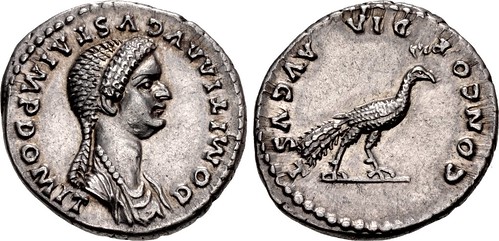
Lot 612 – Domitia. Augusta, AD 82-96. AR Denarius (18mm, 3.56 g, 6h). Rome mint. Struck under Domitian, AD 82-83. DOMITI? ?VGVST? IMP DOMIT, draped
bust right, wearing necklace, and hair massed high in front above forehead and knotted in long plait on neck / CONCOR DIA AVGVST, peacock standing right. RIC
II 151 (Domitian); RSC 2; BMCRE 61 (Domitian); BN 65-68 (Domitian); Jameson –; Mazzini 2. Lightly toned. Choice EF. Very rare and among the finest specimens
known. Magnificent portrait.
Estimated at $10,000
Ex Numismatica Ars Classica 94 (6 October 2016), lot 190; Goldberg 80 (3 June 2014), lot 3142; Nomos 2 (18 May 2010), lot 182.
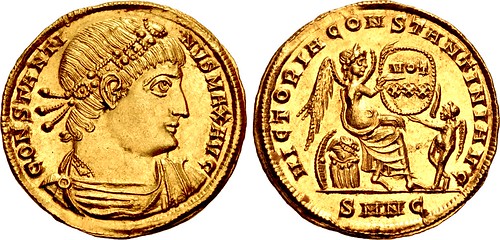
Lot 661 – Constantine I. AD 307/310-337. AV Solidus (21mm, 4.45 g, 6h). Tricennalia issue. Nicomedia mint, 2nd officina. Struck AD 335.
CONSTANTI NVS MAX AVG, rosette-diademed, draped, and cuirassed bust right, viewed from front / VICTORIA CONSTANTINI AVG, Victory seated right on shield and
cuirass, holding wreath or shield enclosing VOT/ XXX in two lines; wreath supported from underneath by winged Genius standing left: SMNC. RIC VII 178; Alföldi
616; Depeyrot 44/2; Biaggi 2017 var. (officina); Jameson –; Mazzini 615/a var. (same). Lustrous, a few faint hairlines in the field on obverse, traces of
deposits. Superb EF. Exceptional strike from fresh dies.
Estimated at $15,000
Ex Dr. Klaus Berthold [“Friend of the Romans”] Collection (Munzen und Medaillen AG 92, 22 November 2002), lot 304; Munzen und Medaillen AG FPL 573 (March 1994), no. 53; Munzen &Medaillen AG FPL 566 (June 1993), no. 35; Numismatic Fine Arts XXIX (13 August 1992), lot 438.
Constantine I “the Great” was one of only three Roman Emperors to ever celebrate a Tricennalia marking 30 years of rule, an event celebrated by the issuance of this gold solidus type from the mint of Nicomedia in AD 335. Constantine had completely revolutionized the Roman world during his long and eventful reign, reunifying the empire after decades of internal division, moving the imperial capital to his own city Constantinople (the renamed Byzantium), and, most importantly, changing Christianity from a small, persecuted sect to the most favored religion of a huge multinational state. Even the visual iconography of coinage saw radical change: Here Constantine adopts an elaborate jeweled diadem in place of the former simple wreath worn by Roman rulers, and his long, carefully arranged hair presages the coiffeurs of medieval kings to come. However, Constantine was at pains to show some adherence to Roman tradition: The figure of Victory accompanied by a small winged Genius on the reverse does show continuity with the pagan past.

Lot 771 – MEXICO, Colonial. Carlos IV. King of Spain, 1788-1808. AV 8 Escudos (37mm, 27.02 g, 12h). Ciudad de México (Mexico City) mint. Dated 1807
Mo TH. Armored and draped bust right / Crowned coat-of-arms within Collar of the Order of the Golden Fleece. BW 33.15; Calicó 1164; KM 159; Friedberg 43.
Toned, faint hairlines. VF.
Estimated at $1,000
From the G.W.K. Roberts Collection, purchased from S.L. Smith, December 1994.

Lot 818 – NORMAN. William I 'the Conqueror'. 1066-1087. AR Penny (19.5mm, 1.42 g, 8h). Profile/Cross Fleurée type (BMC i). London mint;
Eadwine, moneyer. Struck 1066-1068. + PILLEIIS REX ?I, crowned bust left; scepter before / + E?DPINE ON LVNDE, cross fleurée, with pellet-in-annulet at center.
SCBI 20 (Mack), 1348 (same dies); North 839; SCBC 1250. Toned. Good VF.
Estimated at $2,500
Ex Williams Collection; Stack’s ‘Special Offering of British Coins’ (8 April 1989), lot 742.
Printed catalogs for CNG 112 are now available. To order the catalog, please call our U.S. office at (717) 390-9194. Catalogs have been mailed to customers on CNG’s active mailing list. Prospective bidders may also view the virtual catalogs at https://issuu.com/cngcoins/docs/cng_112. The sale can be viewed online at cngcoins.com, sixbid.com, and numisbids.com.
In addition to our Internet &Mail Bid Sale 112, CNG will also feature over 900 lots from many of the same collections listed above in their Electronic Auction 452, closing one week later on Wednesday, 18 September 2019, from 10AM ET (U.S.). Bidding for CNG Electronic Auction 452 will begin on 4 September 2019.
CNG is currently accepting consignments for future auctions sales. Please contact the firm for further details and consignment deadlines.
For further details and any additional information, please contact CNG, LLC at:
Classical Numismatic Group, LLC
P.O. Box 479
Lancaster, PA 17608-0479
Telephone: (717) 390-9194
Fax: (717) 390-9978
Email: cng@cngcoins.com

BOWERS AUGUSTUS B. SAGE MEDALETS COLLECTION
Dave Bowers is selling his reference collection of of Augustus B. Sage Medalets. He wrote about them in an August 15 blog post. -Editor

With a degree of wistfulness I have consigned my reference collection of Augustus B. Sage medalets in the hope that a new generation of enthusiasts will enjoy these pieces as much as I have. If I were not 80 years old I would still seek new varieties! This catalog offers many treasures, with some duplicates to be offered in later sales. However, many in the present offering are unique in my possession and might be unique in an absolute sense. I once wrote a book chapter about Paul Morphy, the American chess wizard, after which I received several inquiries as to where the related Sage medalet could be purchased. But I could not help, as a decade or more can pass between offerings on the market.
As to the issuer: Augustus B. Sage was born in Middle Town (Middletown), CT, on May 13, 1841, the son of Robert and Catharine Sage. His father had come to America from England, and his mother was from New York State. Robert died late in the decade of Augustus' birth. By 1849 or 1850, his widow and her children had moved to lower Manhattan and had taken up residence at 109 Avenue B, moving to 259 Delancey Street by the mid-1850s and to 121 Essex Street by 1857. In 1854 our 13-year-old subject, identified in city records as "A.B. Sage," was earning wages as a primary grade teacher or assistant in Ward School No. 12 at 371 Madison Street in the Seventh Ward, where he remained for the next several years. It seems probable that by 1856, when Augustus B. Sage was only 15 years old, he had been bitten by the coin bug. The recorded story of Augustus B. Sage's hobby-profession seems to commence circa 1856, although tradition has it that Sage may have played a part in the sale of the Peter Flandin Collection at the auction room of Bangs &Co. in June 1855. Perhaps he helped with the catalog as he was not listed as a buyer. About the year 1857 Sage became prominent in numismatics in New York City. The discontinuation of the copper cent and half cent created a nationwide wave of nostalgia, and all of a sudden, thousands of people wanted to learn more.
The New-York Dispatch took a particular interest, and in 1857 Augustus, now 17 years old, using his youthful knowledge and enthusiasm plus extensive reading, set forth to educate readers of the Dispatch., He became a popular columnist—the first in American numismatic history – and his column drew wide interest. Although it is hard to imagine today, in 1857 and 1858 there were no books at all on federal coins. By 1858 Augustus Sage started dealing in coins in a small way, with Henry Bogert as a partner. Tokens and medals interested him in particular. There were no clubs or organizations except the Philadelphia Numismatic Society, which had been organized in January, but had not yet accomplished much.
On March 8, 1858, five socially-minded numismatists in New York—Augustus B. Sage, Henry O. Hart, James D. Foskett, Edward Groh, and James Oliver—affixed their names to a circular letter which invited interested collectors to meet at Sage's family residence, rooms upstairs at 121 Essex Street, New York City, at 7:30 p.m., March 15, to establish what became the American Numismatic Society. Today the ANS names a special club, the Augustus B. Sage Society, in his honor and also has a wonderful collection of his 31 mm medalets and other pieces. The ANS has helped me greatly with research.
In 1858, Augustus Sage was caught up in the great excitement that accompanied the completion of the Atlantic Cable, which transmitted its first message on August 5, 1858. New York went wild, a vast celebration and fireworks display was staged, and a new era was ushered in. Sage set about sponsoring a medal, created by diesinker George H. Lovett, an acquaintance who worked nearby and at the same time produced tokens. In the autumn, Sage launched his own series of tokens, the first called the Odds and Ends series, beginning with the Crystal Palace. These sold modestly, and the Morphy token did not find many buyers. His later series did better, including his Historical Tokens with Revolutionary War and related motifs, his Numismatic Gallery with the portraits of well-known collectors, and, to a lesser extent, Masonic tokens. In addition, Sage produced store cards. All of the above were issued from 1858 to 1860. Later, Lovett made restrikes of some of the Historical and Masonic series pieces.
In 1998 my book, American Numismatics Before the Civil War 1760-1860, Emphasizing the story of Augustus B. Sage was published. It sold well and soon went out of print. Today you can find a copy on the market, but the price is more than the original cost. I guess some of my books have been an investment in themselves, in addition to being an investment in knowledge!
Enjoy the medalets offered here—far and away the largest in numismatic history.
To read the complete article, see:
The Q. David Bowers Reference Collection of Augustus B. Sage
Medalets Featured in Stack's Bowers Official Auction at the ANA World's Fair of Money
(https://www.stacksbowers.com/News/Pages/Blogs.aspx?ArticleID=qdb-sage-medals-2019)
To read the first lot description, see:
1858 Sage's Odds and Ends -- No. 1, Crystal Palace, New York. Original. Bowers-1. Die State I. Copper. Plain Edge. 31 mm. Mint State.
(https://auctions.stacksbowers.com/lots/view/3-J58NA/1858-sages-odds-and-ends-no-1-crystal-palace-new-york-original-bowers-1-die-state-i-copper-plain-edge-31-mm-mint-state)
Here are a few lots that caught my eye. -Editor
Lot 6089: Old Sugar House


"1840" (1858) Sage's Odds and Ends -- No. 2, Old Sugar House, Liberty Street, N.Y. First Obverse Die. Original. Bowers-2a. Die State II. Copper. Plain Edge. 31 mm. 177.2 grains. Choice Proof.
To read the complete lot description, see:
"1840" (1858) Sage's Odds and Ends -- No. 2, Old Sugar House, Liberty Street, N.Y. First Obverse Die. Original. Bowers-2a. Die State II....
(https://auctions.stacksbowers.com/lots/view/3-J58NV/1840-1858-sages-odds-and-ends-no-2-old-sugar-house-liberty-street-ny-first-obverse-die-original-bowers-2a-die-state-ii)
Lot 6096: Charles I. Bushnell


Undated (ca. 1859) Sage's Numismatic Gallery -- No. 1, Charles I. Bushnell. Original. Bowers-1. Die State I. Copper. Plain Edge. 31 mm. Proof, Cleaned.
To read the complete lot description, see:
Undated (ca. 1859) Sage's Numismatic Gallery -- No. 1, Charles I. Bushnell. Original. Bowers-1. Die State I. Copper. Plain Edge. 31 mm.
(https://auctions.stacksbowers.com/lots/view/3-J58P1/undated-ca-1859-sages-numismatic-gallery-no-1-charles-i-bushnell-original-bowers-1-die-state-i-copper-plain-edge-31-mm-)
Lot 6097: Henry Bogert
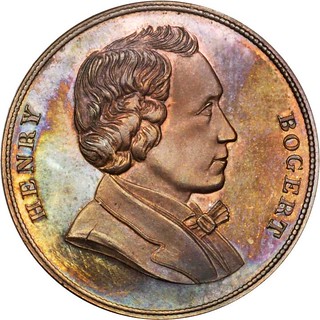

Undated (ca. 1859) Sage's Numismatic Gallery -- No. 2, Henry Bogert. Original. Bowers-2. Die State I. Copper. Plain Edge. 31 mm. Choice Proof.
A semi-reflective beauty with iridescent highlights of gold, pink and steel-blue on medium brown surfaces. Bogert was a friend and one-time business partner of Sage. He was also important in the founding of the American Numismatic Society in 1858.
To read the complete lot description, see:
Undated (ca. 1859) Sage's Numismatic Gallery -- No. 2, Henry Bogert. Original. Bowers-2. Die State I. Copper. Plain Edge. 31 mm
(https://auctions.stacksbowers.com/lots/view/3-J58PH/undated-ca-1859-sages-numismatic-gallery-no-2-henry-bogert-original-bowers-2-die-state-i-copper-plain-edge-31-mm-choice-)
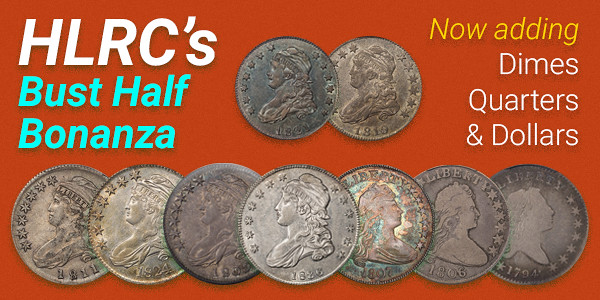
TOM BABINSZKI'S 2019 ANA DIARY
Tom Babinszki publishes the Blind Coin Collector blog. He's an E-Sylum subscriber and contributor, and an avid user of the Newman Numismatic Portal. He was at last week's American Numismatic Association show. He gave a Money Talks presentation Friday morning on "The Challenges of Making Currency Accessible for the Visually Impaired”. I was unable to attend, but I had the pleasure of meeting him for the first time in person at the NBS General Meeting later that morning. Tom published a great blog article on his experience at the show, and we're republishing it here with permission. Thanks, Tom! -Editor
This year I have attended the World’s Fair of Money for the second time. Again, the main reason was because I submitted a presentation which was accepted. Learning from the previous experience in 2015, I prepared very differently this time.

Tom Babinszki (center)
The first thing I wanted to avoid is random exploration. While there is always room for random ideas and meetings, last time I found the floor quite overwhelming, and there were more meetings and presentations I could possibly attend. This time, I came for four days, made a calendar of events I wanted to attend, but most importantly a list of tables I wanted to visit in numerical order. Last time it was a mistake just to take chances. I may have visited more people, and touched more coins, but this time I decided to put more effort into learning and meeting people. This approach worked much better.
The floor is huge. I can’t even guess how big, there were at least 15 long isles, with tens of tables in each. Especially in the crowd, I could not make any sense of the layout. Baldwin was helpful in navigating obstacles, make sure I don’t bump into people and tables, but I certainly needed help along the way. This is why I wrote out in braille all the tables in numerical order I wanted to visit. I started at the beginning, and when I was done with one table, I asked for directions to the next one, which wasn’t always the nearest, but for the most part this approach worked out. People were extremely helpful, I often got much more than directions, there was always somebody who offered to take me to the next table. I am especially thankful to Carl Wolf and his volunteer team, who was always ready to help.
This time I stayed at the Hilton, which was easier to find from the convention center, at least for the most part I didn’t need help there. The hotel was also a bit complex with all kinds of curves and corners, but after the first day I was able to navigate to the most important places with Baldwin. He just knows what we do. Often he guessed where I wanted to go as if he understood what I said.
I arrived on Wednesday, fortunately the Hilton allowed me to check in before noon. After a quick coffee, I couldn’t wait to go over to the convention center. I started at the Chicago Coin Club, to say hi to Carl Wolf, then went over to the Numismatic Bibliomania Society table, where I met some interesting people. I knew most of the names, and corresponded with some of the people, but I never met them in person. I met with Len Augsberger, with whom I have corresponded quite a bit recently, and also found out that Joel Orosz does not only have a Hungarian last name, but he considers himself Hungarian.
I spent the rest of the afternoon visiting some of the mints. I wanted to touch base with them regarding accessible currency. Ok, it is not the mints who produce banknotes, but I thought they would be the closest to it from any given country I would be able to talk with. For the most part, I came away with new information. It was great to see Kevin Brown again at the BEP, he even called my attention to the Dollar bill signing by the BEP director.
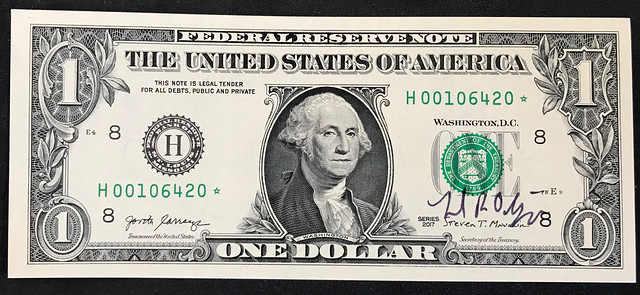
 I got to touch the new Canadian high relief coin. It was interesting to feel, a bit stretching the idea of what I thought a coin was.
I got to touch the new Canadian high relief coin. It was interesting to feel, a bit stretching the idea of what I thought a coin was.
On Thursday I started with Shanna Schmidt‘s table, whom I know from the Chicago Coin Club. It was great to see her, after reading her weekly newsletters. Even though I am not going to be her ideal client, her newsletters are always interesting and useful. He does not only sell, but also educates. I would highly recommend it to anybody, even if you are not collecting ancient coins.
Later I attended the Numismatic Literary Guild’s symposium and the NBS meeting as well. After the NBS meeting, I was trying to organize a short get-together for the WINS members who were attending, but only two of us showed up. The third one, John Baumgart was probably getting ready for his presentation, which we went to attend in the afternoon. He was talking about Morgan dye varieties. The kind of topic I will never be able to truly understand or appreciate without vision, so it was particularly interesting to me to learn something new from him.
On Friday before my presentation, I decided to arrive early and attend the previous presentation as well. Great idea. It was Jamie Franki, who designed the ANA convention medal this year, and he is also the designer of the Jefferson Nickel’s obverse. His presentation was engaging and interesting, I was a bit worried about talking after him.
My talk was about the challenges of making currency accessible for people with visual impairments. It was great that two people from the BEP came to attend. As I started out, all that could go wrong, went wrong. I wasn’t sure if I had the right cable, which we finally resolved. Then I could not hear the screen reader in my ear, it was coming through the computer speaker while everything else came through the earphone. I didn’t want to spend time on figuring it out. Then I could not exit the presenter mode, so the presentation showed differently from how I normally view it. All I could hear was the slide titles, and I had to remember the slide content. Normally I present from another laptop, I used this one for the first time, and I didn’t tested it at home, I thought I knew how it worked, but I would have needed 10 more minutes to get this right. Well, fortunately the presentation was my creation, though I forgot to mention some major things, I remembered most of it by heart. After I got over the initial excitement and decided that there was nothing I can do about it other than embarrassing myself, I just pretended that I knew what was on the slides.
The pictures I showed were of banknotes, and I brought a folder with the actual notes and I passed them around for the audience to enjoy. It was one of those shows where people were encouraged to touch and feel the notes. I only brought banknotes which were not too difficult to replace, so I didn’t care what would happen to them. I think the folder was going around for some 20 minutes, I hope they enjoyed the experience.
After my presentation I went to the NBS meeting which mostly consisted of an auction, then Wayne Homren talked about the e-Sylum and Len Augsburger about the Newman Numismatic Portal. Amongst many things, I have learned that Wayne named Howard Berlin the Numismatourist. Also, I met Wayne for the first time in real life.
 I got a book at the auction, I didn’t even know this book existed, but it sounded exactly like something that’s missing from my library, the
numismatic history of Congo/Zaire.
I got a book at the auction, I didn’t even know this book existed, but it sounded exactly like something that’s missing from my library, the
numismatic history of Congo/Zaire.
Some more table browsing in the afternoon, mostly unsuccessful, it appeared that many people left their tables probably to see the other ones. The last event was the International Primitive Money Society meeting. As always, Deven Kane gave an outstanding presentation about South-East Asian primitive money. I had a chance to meet some interesting people again, including Chuck Mitton who told me about his world travels in the 60’s, when he was Hunting in Africa. I was asking him if he knew any of the famous Hungarian hunters who’s books I grew up on, and while he didn’t, the question wasn’t all that unreasonable, as his wife’s relatives are Hungarian.
On Saturday, I did some last minute rounds to try to meet a few people I missed, and at last I attended the Chicago Coin Club’s meeting, which was commemorating the 100 years of the club. Tom Uram did the presentation, who is a member of the CCAC. He discussed many interesting things, including what it is like to work with the CCAC that I was interested in.
One of the takeaways this year is the generosity of people. It was amazing to talk with many interesting people of whom I knew, but I never met them in person. They were generously sharing their knowledge with me, or for that matter, with all people.
How about that dollar bill signed by Director Ryder? It's a star note! I never ran into the Director at the show, athough I did spot him heading to the elevators in the Crowne Plaza while I had a bite to eat Thursday evening at the bar with Pat McBride. Did any of our readers get to meet him? Did anyone else get a signed dollar? -Editor
To read the complete article, see:
World’s Fair of Money 2019
(https://blindcoincollector.com/2019/08/19/worlds-fair-of-money-2019/)

WAYNE'S 2019 ANA DIARY: PART I
Thursday, August 15, 2019
You know those trips where everything that can go wrong, does? Well, my trip to Chicago for the 2019 American Numismatic Association World's Fair of Money was the opposite of that. I got up early and drove to the long-term parking lot at Dulles Airport. The parking shuttle came quickly, there was no line at security, boarding went smoothly, I got the next-to-last space in the overhead bins for my luggage, the hotel shuttle arrived within minutes, and checking into the Crowne Plaza at Rosemont at 10am local time I snagged the last currently available room. I was blessed. After dropping off my things I made my way across the street to the convention center.

I've been to enough of these shows that I have a game I like to play on arrival - which numismatic friend or celebrity will I run into first? It should have been an easy call. Carl Wolf of the Chicago Coin Club was among the members manning a table just inside the door.
But I didn't have a lot of time so I started heading toward the room upstairs where the Numismatic Bibliomania Society board meeting would be held, and crossing the lobby I practically stumbled right into NBS President and Treasurer Tom Harrison and Chuck Heck. Together we made our way to the room where Len Augsburger was having a conversation with Ken Bressett and Dennis Tucker of Whitman Publishing. It was great to see them all, and the Redbook Editor Emeritus was looking hale and hearty. He and Dennis had to head over to the Numismatic Literary Guild awards lunch.
Soon the NBS Board was assembled for our meeting. It was a good one, kept moving along by Tom and featuring a great analysis of our financial position by Chuck. Bottom line: we're solvent! But there are always issues to address or be mindful of, and I think it was a very productive meeting with some interesting ideas for moving forward.
I had given an update on the E-Sylum ANA edition, but ducked out a bit early to run over to the NLG event. The E-Sylum didn't come away with a plaque this year, but I got to sit down with my fellow Nummis Nova members Dave Schenkman and Eric Schena, and have a nice brownie for a snack. I heard Ron Guth give a great history of how he built, sold and developed his CoinFacts site. Afterwards I met up with Mark Ferguson, who had been ably assisting with the NLG awards.
Next I found Bob Van Ryzin and Tom Michael at a table in the hallway. It was my first time meeting Tom in person. He's edited umpteen books at the former Krause Publications and is now with AIM Media, the new owner following the bankruptcy of parent company F+W. Bob had earlier retired after a long career writing and editing at Krause. I was pleased to hear that the new owners were eager to learn about the numismatic market, retain the Coin of the Year program and rebuild the publications.
Around the corner I found Dennis Tucker sitting with Bill Bierly reviewing proofs of his upcoming book on the In God We Trust motto in U.S. numismatics. It looks like a landmark work. I noted that for years the only information I had in my library on the topic was a thin pamphlet. This will be a meaty, well-researched book with many great photos.

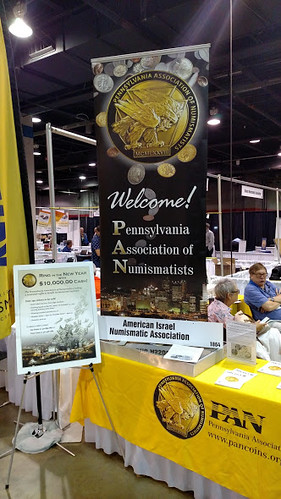
Show signage
Walking onto the bourse floor I ran into both Dan Hamelberg and Benjamin Franklin (my old friend Pat McBride dressed in full costume and going in and out of character). I introduced him (them?) to Dan and we had a nice chat. I asked Ben to refrain from taking air baths during his stay.

Alan Workman, Dan Friedus, and Marc Ricard at the NBS table
I next found my way to the NBS table between numismatic literature dealers Charlie Davis and Kolbe & Fanning. I was there to meet up with Alan Workman who is working on upcoming numismatic literature sales of his own. I learned that the table had been swamped with visitors the day before. Here's a report from Mike Marotta.

Tom and Pam Harrison at the NBS table; Photo by Mike Marrotta
Mike Marotta writes:
I attended the 2019 World's Fair of Money only for August 12th and 13th in order to speak at the Sundman Lecture Series. I arrived Tuesday afternoon and immediately went to the bourse floor. I met NBS members Joel Orosz, Len Augsburger, George Kolbe, and Betty Lawrence at the Kolbe & Fanning booth. Next to them, Tom Harrison and Pam Harrison were staffing the NBS club table.
Also on the floor, Gilman Parsons from Sonoma, California, (Booth 1622) was offering books that cost about as much as a home.
Before long Len Augsburger was back at the table again. LongtimeE-Sylum supporter Doug Winter dropped by and Len and I had a nice conversation with him on multiple topics, including venues for the ANA shows.
Throughout the rest of the show the table was manned at various times by myself, Kellen Hoard, Chuck Heck, Len Augsburger, and NBS President Tom Harrison and wife Pam. On display were some auction lots for the next day's fundraising sale.

Charlie Davis and Neil Musante at Charlie's table
The rest of my afternoon at the show was spent marching up and down the aisles.

Ken Barr and Stephen Patrick at the Souvenir Card Collectors table
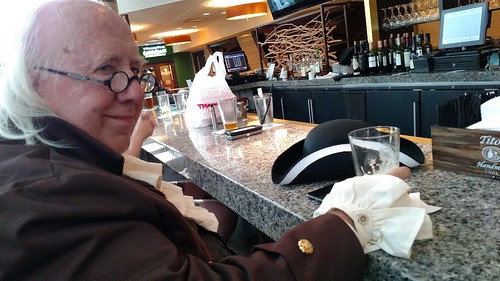
Around 6 o'clock I ran into Ben Franklin having an ale at the Crowne Plaza bar. I joined him and ordered a sandwich for dinner. Fellow bar patrons took their photo with him, holding up a $100 bill. "It's all about the Benjamins!", they said.
IAPN Cocktail Party
I was invited to the evening's Cocktail Party for the International Association of Professional Numismatists (IAPN). It was an enjoyable evening. I got to
meet Catharine Lorber and her husband and several dealers from around the U.S. and the world. I as also able to spend some time chatting with Kerry Wetterstrom
of Classical Numismatic Group. See the earlier article in this issue for IAPN's presentation of their 2018 Book Prize to Catharine Lorber.


That was enough for me for one day. I returned to my room where I was serenaded by fireworks from the nearby concert venue.
Friday, August 16, 2019
Signing the SS Central America Book
One of my first stops Friday morning was to the Goldberg's table to pick up a copy of the new book on the SS Central America treasures. There I ran
into Bob Evans, Joel Orosz, John "JD" Dannreuther, and Dwight Manley.

Bob Evans filling out a receipt
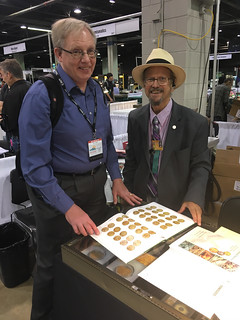
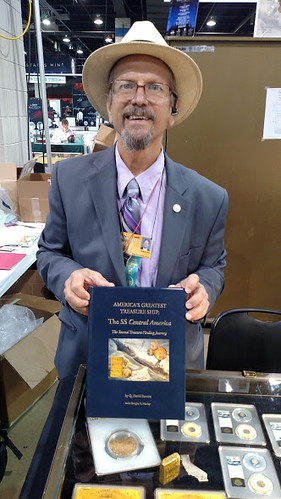
LEFT: Wayne Homren, Bob Evans
RIGHT: Bob Evans with a Deluxe copy

JD, Dwight Manley, Bob Evans, Wayne Homren. Photo by Joel Orosz
NBS General Meeting
I'm running out of time to complete this diary, and I know the event will be well covered in our print journal, The Asylum. So here are a few photos
of our General Meeting and a link to a Flickr gallery for more.

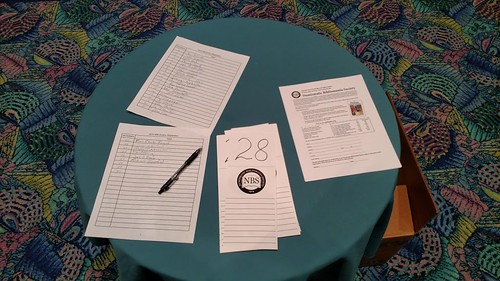
Bidding paddles

Some auction lots

Kellen Hoard speaking with Tom Babinski
To visit the photo gallery see:
2019 ANA NBS General Meeting
(https://www.flickr.com/photos/coinbooks/albums/72157710431581326)
Karl Moulton
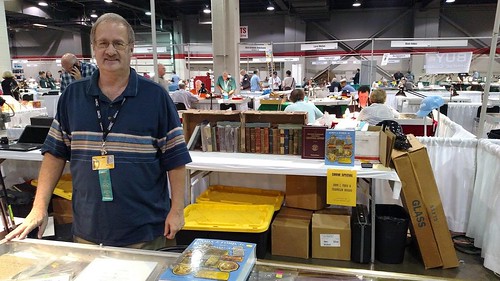
I had a great conversation with Karl Moulton at his table, where I enjoyed looking at some of his numismatic literature.
We'll save some more for next week. What a great show it was.
THE INVASION OF CHAMPAIGN
There will also be much more on the NBS visit to the library of Dan Hamelberg in Champaign, IL in The Asylum and next week's E-Sylum. Here's a group photo by Lianna Spurrier, courtesy of the Eric P. Newman Numismatic Education Society.
Caption and much more next week!

THE VAMPIRE NOTE NOTE FOUND IN A HEDGE
A common note was found in an uncommon place in Reading, England. -Editor

This has to be one of the most bizarre discoveries made in Reading this year.
Amateur photographer Callum Cromwell said he was walking through Sycamore Road in Whitley when he found the note lying in a bush.
The note is for 10,000 German marks, and comes from a particularly bleak period in Germany's interwar past.
The note was issued by the Reichsbank, the German national bank of the time, in February 1922, during a period of hyper inflation of the German currency.
The inflation of German currency was partly down to the huge war reparation costs imposed on the nation by the Treaty of Versailles, which forced the country into even deeper debt.
The German website Sammler says that by the end of 1923, wages were paid in wheelbaskets full of worthless notes.
Unfortunately for Mr Cromwell, of Reading, Berkshire, the bank note cannot be cashed in for euros.
But what of the man featured on the note itself?
It's actually a piece of art by one of Germany's most famous painters.
The picture is the Portrait of a Young Man, by artist Albrecht Durer, who lived during the Renaissance period.
This is quite a common note - I had one of these as a young collector, probably acquired as part of some promotion. I've forgotten where it ended up. I doubt this piece was outdoors for decades - it was probably lost or discarded fairly recently. -Editor
To read the complete article, see:
The story behind the unusual banknote found in a
hedge in Whitley (https://www.getreading.co.uk/news/berkshire-history/story-behind-unusual-banknote-found-16764670)
The note is great for promotions because it's also known as "The Vampire Note". Turn it 90 degrees counterclockwise and place your left thumb over the man's face. Then the man's neck looks like a sucking vampire. Here's the story from a page on the BanknoteDen.com site. -Editor
The German economy was quickly going into a downward spiral with no foreseeable way out. As the treaty was signed in Versailles, there was considerable blame laid upon the French for the economic drain placed on Germany. They felt as is they were being bled dry through the reparations. This banknote depicts this feeling of the German people well. This note depicts the anti French sentiment held by most Germans at the time.
 Although Durer’s painting “Portrait of a young man” was chosen to be on the banknote, this painting was slightly altered by the engraver at the
Reichsdruckeri, who had altered the banknote in the neck of the portrait to depict a rather gothic looking vampire, representing France, which is sucking the
life blood out of the throat of Germany through reparations for World War I. It takes a bit of imagination, and a ninety-degree turn of the banknote to the
left, to see the hooded vampire, but once spotted, it is readily noticeable from then on. There were three variations of the note yet the altered design of
Durer’s portrait was not corrected, showing obvious anti French sentiment held by the Reichsbank at the time.
Although Durer’s painting “Portrait of a young man” was chosen to be on the banknote, this painting was slightly altered by the engraver at the
Reichsdruckeri, who had altered the banknote in the neck of the portrait to depict a rather gothic looking vampire, representing France, which is sucking the
life blood out of the throat of Germany through reparations for World War I. It takes a bit of imagination, and a ninety-degree turn of the banknote to the
left, to see the hooded vampire, but once spotted, it is readily noticeable from then on. There were three variations of the note yet the altered design of
Durer’s portrait was not corrected, showing obvious anti French sentiment held by the Reichsbank at the time.
To read the complete article, see:
(http://www.banknoteden.com/Germany.html)

BOOKSTAGRAMMERS AND BOOKTUBERS
The latest craze in the biblo-world, from a recent Washington Post article. -Editor
 To put a literary spin on an adage: If you read a book but don’t post about it on social media, did you really read it?
To put a literary spin on an adage: If you read a book but don’t post about it on social media, did you really read it?
On Bookstagram, a niche corner of Instagram, readers share dazzling photos of single books, stacks of books, coffee and books, nature and books. Books that never looked so good. And on YouTube’s BookTube, bibliophiles upload vlogs, or video logs, anywhere from a couple minutes to more than an hour long. Some BookTubers specialize in spirited reviews; there’s an account that posts live-action illustrations of C.S. Lewis essays, and another that analyzes the classics in gangster-speak.
In these sprawling but welcoming communities, readers have found one another, banding together in a global, aesthetically pleasing book club that’s open for discussion 24/7. More than 33 million Instagram posts are tagged “#bookstagram,” and BookTube videos can amass millions of views — luring publishers and authors who actively court the most popular accounts. We asked three ’grammers and ’tubers — otherwise known as book influencers — to describe their experiences in these online communities that are so warm, they feel like social media’s best.
To read the complete article, see:
https://www.washingtonpost.com/entertainment/books/the-bookstagrammers-and-booktubers-changing-the-way-we-read/2019/08/06/60b76d6a-afb6-11e9-8e77-03b30bc29f64_story.html
(https://www.washingtonpost.com/entertainment/books/the-bookstagrammers-and-booktubers-changing-the-way-we-read/2019/08/06/60b76d6a-afb6-11e9-8e77-03b30bc29f64_story.html)


